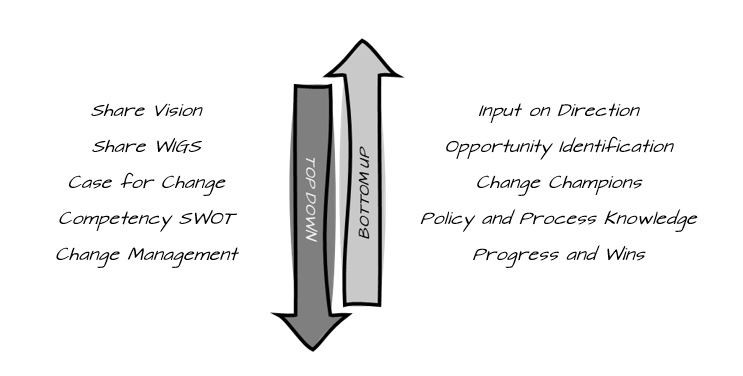The Transformation Triangle
Change is hard.
Years of leading transformations has taught me that it’s no easier on the people leading the change. Organizations typically have a playbook for BAU, but there is no playbook on how to change the organization itself.
So, over time, and through many lessons learned, I’ve created one. It’s called the Transformation Triangle.
A clear structure not only encourages buy-in, it can also provide guardrails for creativity and innovation – even through change. The goal of this framework is to put transformation on tracks and hyper-focused on what matters most.
It looks like this:
We’ll start with the center of the triangle as that’s what everything revolves around.
PRIORITIES / WIGS
The leadership team must be absolutely clear on their goals, and it’s all about prioritization.
During a large transformation, everything seems equally important. The reality is that just isn’t true.
By forcing yourself, and your team align on one WIG at a time, you will stay focused and keep your efforts manageable.
Only once your WIGS are clear are you ready engage your people.
If you want to learn more about WIGS, see this great book from which the term came.
PEOPLE
Engaging the organization is not a one-off exercise. It is a constant top-down and bottom-up effort throughout a transformation, communicating the priorities, allowing time and space for dialogue, and ensuring the right team is in place to support the direction.
The objective is to make sure the right people are on the bus, they know where they’re headed, and why.
PROCESS
The next step is to tackle the processes critical to the change.
Identify the processes that most impact your WIGS, and conduct an audit.
The goal is to identify the universe of potential changes that can help you achieve your goals, remove the process barriers standing in your way, and then prioritize based on your organization’s capacity for change.
You are better off delivering clear wins early. Even small successes can have a big ripple effect that keeps everyone motivated. Don’t try to change everything at once or you will overwhelm the organization – and yourself.
PROGRESS
The secret sauce in change management is demonstrating progress.
If you clearly link your WIGS to measurable KPIs you will find the change starts to reinforce itself.
Don’t fall into the trap of focusing strictly on lagging external indicators (e.g., revenue growth). Those are great, but often the last indicators of progress.
The goal is to demonstrate early wins, and build confidence that the external, long-lead wins are coming.
A true transformation should track KPIs in all 4 buckets:
Don’t over-engineer them. Something as simple as a survey at the end of a meeting can be an effective leading indicator, that demonstrates positive cultural change.
CHANGE IS A CYCLE
Transformation isn’t a one-way trip.
Once the WIGS have been hit the process restarts with new WIGS.
Eventually the Transformation Triangle starts to look more like a flywheel.
Consistent, demonstrated delivery against clear WIGS is what sustains transformation.
Priorities channel energy and inspire the change, people and process efforts make it happen, and progress keeps the organization hungry for more.
Could this article help someone in your network wrap their head around a complex transformation? Share below!


























